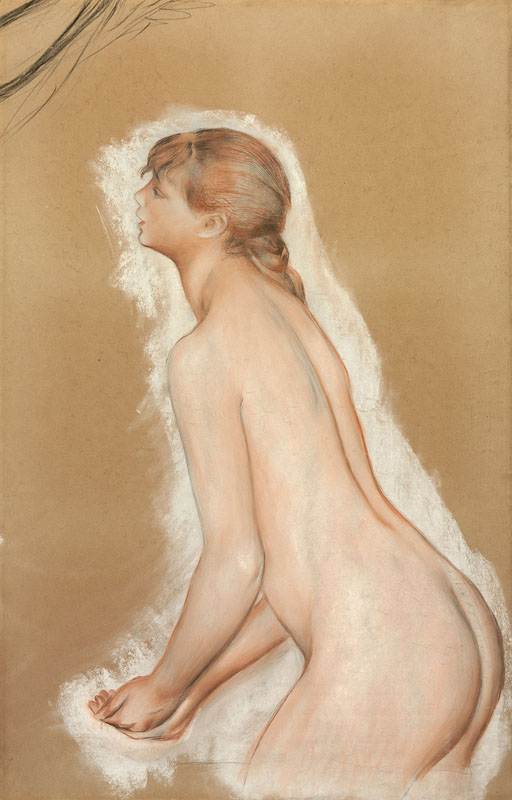Listen to director and curator Colin Bailey describe a study for Renoir’s monumental Great Bathers painting.

One of Renoir’s greatest drawings from any period, this large study in three chalks was executed in a different technique than the other preparatory works for The Great Bathers. The figure was first outlined in black over a base of white, with the flesh tones modulated in red and black chalks that were stumped and blended. Although this sheet is also more highly finished than the others, it reflects Renoir’s preliminary ideas about the bather’s coiffure and hands. Similarly, the rough black strokes at upper left, which evoke the absent middle bather’s left arm and the branch for which she reaches, recall the Musée d’Orsay’s early study. While Renoir seemingly produced Splashing Figure as an independent work for the market, he kept the drawing for twenty years before selling it to Ambroise Vollard in 1908.
Splashing Figure (Study for “The Great Bathers”), ca. 1886–87
Red, white, and black chalk, with stumping, and black Conté crayon on tracing paper, mounted to canvas
The Art Institute of Chicago, bequest of Kate L. Brewster, 1949.514
The Art Institute of Chicago / Art Resource, NY.
This single-figure study of the standing bather on the right is unusual among the preliminary drawings for the Great Bathers in its high degree of finish. Renoir combined a base of white chalk over the tan paper with layers of red, white, and black chalk and sharply delineated contours, and then smudged and blended certain areas with such finesse that the resulting surface appears nearly as soft and translucent as actual skin. While the other large sketches can be organized into a plausible sequence that traces the development of Renoir’s compositional ideas, this sheet stands somewhat apart. The figure’s near-profile stance and relatively straight back are similar to those in the earliest sketches, and the heavy strokes of black chalk in the upper left corner may be remnants of the initial conception of the central bather reaching up for a tree branch. In the more roughly-drawn red chalk study next to this work, the bather takes a more twisting pose and extends her head further forward, while her left leg advances in a wider stance, closer to that of the figure in the final painting. Renoir may have started this drawing at an early phase of the process and then, perhaps pleased with its appearance, decided to develop it more fully as an independent work.
